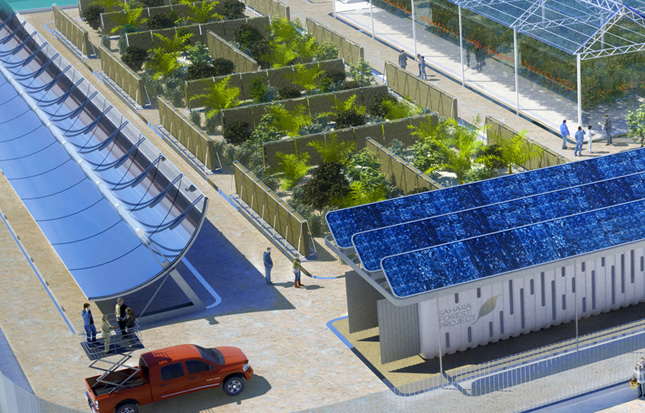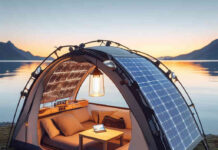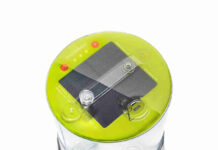
A one hectare site outside Doha, Qatar, will soon host the Sahara Forest Project Pilot Plant. It will contain a unique combination of promising environmental technologies carefully integrated in a system to maximize beneficial synergies.
A wide specter of leading experts and technology developers are taking part in the effort to realize the project. A cornerstone of the pilot is greenhouses utilizing seawater to provide cool and humid growing conditions for vegetables. The greenhouses will also produce freshwater themselves. The greenhouses will be coupled with a state of the art parabolic trough solar collector with a thermal desalination unit supported by PV-technology. The pilot will also allow for cultivation of algae in a system of photobioreactors and open pond cultivation systems.
An important part of the pilot is to demonstrate the potential for cultivating desert land and making it green. Outdoor vertical evaporators will create sheltered and humid environments for cultivation of plants. Additionally, the pilot will contain outdoor hydroponic raceways for cultivation of halophytes – plants tolerant of irrigation with salty water. The facilities in the pilot plant will be supported by on-site laboratories, scientists and professional growers.
Concentrated Solar Power
A strikingly simple interface will replace the water-thirsty cooling towers of a typical concentrated solar power plant with a saltwater cooling system that utilizes greenhouse roofs to dissipate the waste heat from the concentrated solar power process. At the Pilot Facility, Sahara Forest Project will demonstrate an innovative greenhouse- concentrated solar power cooling system, which enables the low-cost use of saltwater to achieve wet-cooling efficiencies without utilizing precious freshwater resources.
The heat from the concentrated solar power mirrors will be used to drive a multistage evaporative desalination system for production of distilled water for the plants in the greenhouse and outside. The waste heat is used to warm the greenhouses in the winter and to regenerate the desiccant used for dehumidifying the air.
The SFP Pilot Facility will be home to the first fully operational concentrated solar power unit in Qatar. It will be used to measure the performance of concentrated solar power collectors in Qatari conditions, providing vital information for future larger scale solar power facilities. So too will the Pilot provide the first testing ground to examine the impacts of co-locating concentrated solar power collectors with revegetated areas, in which plants and humidifying hedges can reduce the dust levels that can reduce the performance of solar energy systems, and partially protect the valuable concentrated solar power mirrors from harsh desert winds.
Saltwater greenhouses
Saltwater-cooled greenhouses will provide suitable growing conditions that enable year-round cultivation of high-value vegetable crops in the harsh Qatari desert. The greenhouse-structure will consist of 3 bays that will compare the performance of ETFE and polythene roof coverings on the horticultural yield. The cooling system will be an evaporative cooler at one end of the greenhouse. The cool air will be supplied under the plants via polythene ducts to ensure that the cool air is distributed evenly along the greenhouse and at low level. As the air heats up it rises and is expelled via high level openings in the end wall.
The middle bay will have a twin skin ETFE membrane roof that forms a void over the greenhouse. This is linked to an evaporator pad and fan that can use the waste heat from the concentrated solar power to evaporate seawater or regenerate the desiccant and produce hot moist air. When the air is passed through the void at night it will cool and the moisture in the air will condense out to give fresh water that can be used for irrigation of the plants.
By using saltwater to provide evaporative cooling and humidification, the crops’ water requirements are minimized and yields maximized with a minimal carbon footprint.
Outside vegetation and evaporative hedges
The water coming from the greenhouse will be at a concentration of about 15 % salinity. To reduce the water content further, the brine will be passed over external vertical evaporators set out in an array to create sheltered and humid environments. These areas will be planted to take advantage of the beneficial growing conditions for food and fodder crops and for a wide range of desert species. New candidate species for use as harvested and grazing fodder for livestock, and as bioenergy feedstock, will be identified and characterized from among native desert plants. The carbon sequestration benefits of various planting and cropping approaches will be measured and compared.
Photovoltaic Solar Power
The Pilot Plant will be supported by state of the art PV-technology. Dust arresting from the surrounding vegetation and water for cleaning the PV-panels will ensure an efficient electricity generation.
Salt production
As the water is evaporated from saltwater the salinity increases to the point that the salts precipitate out from the brine. The last stage of this process will take place in conventional evaporation ponds
Halophytes
Beyond traditional horticulture and agriculture, halophytes – salt-loving plant species – will be cultivated in saltwater. These hardy plants, often already well adapted to desert conditions, are highly promising sources of fodder and bioenergy feedstocks that can thrive in highly saline environments. However, irrigating with saltwater directly into the soil can cause significant environmental harm. The Qatar Pilot Facility will implement and test a variety of novel cultivation techniques to allow low-cost halophyte cultivation while ensuring no saltwater enters surrounding soil or groundwater aquifers.
Algae production
A state-of-the-art 50 m3 algae test facility – the only of its kind in Qatar and the larger region –will enable commercial-scale research on the cultivation of marine algae species native to the Gulf and Red Sea for use as nutriceuticals, biofuels, and as animal and fish fodder. New synergies with the SFP saltwater-greenhouse infrastructure, mariculture operations, and soil remediation methods will be optimized, while cutting-edge research in cultivation and harvesting methods is carried by SFP staff and its team of international collaborators.



